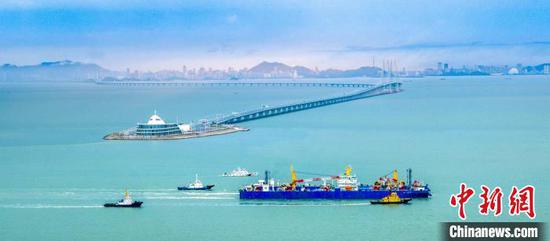Docking completed on Shenzhen-Zhongshan Bridge undersea tunnel
After five years of construction, docking of the final joint of the undersea tunnel of Shenzhen-Zhongshan Bridge, a mega project in the Guangdong-Hong Kong-Macao Greater Bay Area (GBA), was completed, marking the closure of the world's longest and widest immersed tube tunnel, China Communications Construction Co (CCCC) said on Sunday.
Experts call the project "important and significant" to pushing city cluster integration in the GBA. Along with other key infrastructure projects pursued recently, it will also provide powerful momentum for the country's economic growth this year, they said.
According to a statement sent by the CCCC to the Global Times, the final joint of the tunnel, which weighs 1,600 tons, was pushed at a slow speed of about 5-10 millimeters every minute on Saturday afternoon and docked with the E24 tube section on Sunday morning.
Ning Jinjin, deputy general manager of the project with CCCC First Harbor Engineering Co Ltd, told the Global Times on Sunday that the project set several world engineering records. The extended length from the E23 tube to completion of the final joint, at 2.04 meters, is the world's longest, Ning said.
"The 6,845-meter-long subsea tunnel is also the world's longest and widest undersea steel shell concrete tube tunnel," Ning said.
The bridge connects Shenzhen and Zhongshan in Guangdong Province, which is a cross-sea infrastructure project integrating "bridges, islands, tunnels and underwater communications", according to the project's WeChat account.
Experts said that the project is crucial for the development of the Pearl River West Bank region.
"While the Hong Kong-Zhuhai-Macao Bridge addresses transportation issues among Hong Kong, Macao and the Pearl River Delta, traffic between eastern and western Guangdong Province mainly relies on the Humen Bridge and the more distant Nansha Bridge," Lin Jiang, a professor of economics at Sun Yat-sen University, told the Global Times on Sunday.
Lin stated that Zhongshan and Jiangmen are the two most important cities on the Pearl River West Bank and also key cities in the GBA. With the opening of the bridge, it will connect the eastern and western banks of the Pearl River and link several cities on the relatively underdeveloped west bank, including Zhuhai, Zhongshan and Jiangmen, to Shenzhen on the east bank.
According to media reports, the project will reduce the travel time between the two cities from 2 hours to about 20 minutes. It's expected to be completed in 2024 with an estimated investment of 44.69 billion yuan ($6.18 billion).
It will boost the flow of resources such as capital, talent and technologies in the GBA, stimulating the area's economic growth, experts said.
"It (the bridge) may even spread the influence of Hong Kong's modern services industry to the west bank and expand toward western Guangdong," Lin said, and the smooth flow of people and goods between the west and east banks of the Pearl River will increase, becoming an important basis for local government planning and economic development.
China has been pushing for progress on major infrastructure projects. Near the end of last year, the Baihetan hydropower plant became fully operational. Other major construction projects also advanced recently, such as holing through the first tunnel along the Nanchang-Jiujiang high-speed railway.
Chen Jia, a veteran macroeconomist, said that such infrastructure projects reflect the technological strength of China's manufacturing industry, which is central to China's ability to overcome external risks and shore up economic fundamentals.
He also noted that such "benchmark" infrastructure projects can boost public confidence and national pride too.
"The BeiDou Navigation Satellite System, manned spaceflights...these are good examples of China using comparative advantages in manufacturing industries to push economic growth," Chen said.

